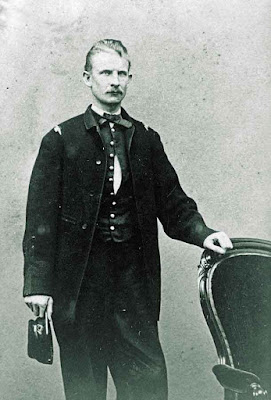However, often overlooked is their true baptism in combat early on the morning of June 15 at Baylor's Farm during the approach to Petersburg's defensive line.
The USCT division, commanded by Gen. Edward Hinks, consisted of two brigades. Col. Samuel A. Duncan led the brigade composed of the 4th, 5th, 6th, and 22nd United States Colored Infantry regiments. Col. John H. Holman was in charge of the other brigade, which only contained the 1st USCI and 5th Massachusetts Colored Cavalry.
During the night of June 14/15, Duncan's Brigade moved from their encampment at Point of Rocks on the Bermuda Hundred to the south side of the Appomattox River via a pontoon bridge placed at Broadway Landing. At near the same time, Holman's Brigade moved from their City Point camps to junction with Duncan's Brigade in preparation to attack Petersburg. White divisions in the XVIII Corps maneuvered just to the west, near the City Point Railroad line.
Blocking Hink's route to Petersburg along the City Point Road was an earthwork emplacement containing infantry and artillery at Baylor's Farm. The location of this engagement is now near where I-295 and Hwy. 36 intersect in Prince George County, on the southwest side of Hopewell, Virginia.
The following is the portion of Colonel Joseph Kiddoo's (22nd USCI) official report that concerns the action at Baylor Farm:
"On the morning of the 15th I moved with the rest of the brigade from Spring Hill on the City Point road. Approaching the enemy's advanced line of rifle-pits near Baylor's house, I received orders from the colonel commanding the brigade [Duncan] to form line of battle and advance, the Fifth U.S. Colored Troops being at the same time on my right and the Fourth U.S. Colored Troops on my left. I also received orders from the colonel commanding to be ready to charge when ordered. After I had gotten under the fire of the enemy's artillery, concluding that on account of the broken nature of the ground orders could not reach me to charge, or that I could not be found, I took the responsibility and ordered my regiment to charge the line of rifle-pits in my front. The effect with which the enemy's artillery was playing upon my line was the strongest inducement for me to give this order. The charge was gallantly made, and that portion of the rifle-pits in front of my line possessed, together with one 12-pounder howitzer, from the fire of which my men suffered severely while coming through the woods. From thence I marched with the rest of the brigade to the left and toward the main line [Dimmock Line] of the enemy's works."
As Kiddoo's men charged, they yelled "Remember Fort Pillow!" The New York Herald correspondent, Mr. J. A. Brady, shared a report that published on June 20, 1864. It reads:
"With a wild yell, that must have certainly struck terror into the hearts of their foes, the Twenty-second and Fifth United States colored regiments, commanded by Colonels Kidder [sic] and Conner, charged under a hot fire of musketry and artillery over the ditch and parapet, and drove the enemy before them capturing a large brass field piece, and taking entire possession of their works."
Brady continued: "When the negroes found themselves within the works of the enemy no words could paint their delight. Numbers of them kissed the gun they had captured with extravagant satisfaction, and feverish anxiety was manifested to get ahead and charge some more of the rebel works. A number of the colored troops were wounded and a few killed in the first charge. A large crowd congregated, with looks of unutterable admiration, about Sergeant Richardson and Corporal Wobey [sic], of the Twenty-second United States colored regiment, who had carried the colors of their regiment and had been the first men in the works."
The 22nd USCI went on to have tremendous success later that day at Petersburg capturing a portion of the Dimmock Line. However, it is important to remember their marked success earlier in the day, too.




No comments:
Post a Comment